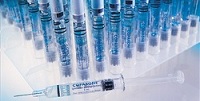Here's more evidence for cynicism about drug pricing. The cost of multiple sclerosis drugs has skyrocketed over the past 20 years, and it's not just new drugs driving that increase. Not one MS drug has a list price of less than $50,000 per year in the U.S., and some treatments cost 7 times more now than they did in 1995, a new study found.
In fact, one drug first priced at $8,700 now carries a sticker price of $62,400, according to the study published in the journal Neurology.
Oregon State University researchers looked at first-generation drugs that made their debuts in the 1990s. Back then, prices ran $8,000 to $10,000 per year, they found. As more drugs entered the field--presumably increasing competition for patients--the prices of these older meds soared anyway.
Over the same timeframe, inflation in general, and prescription drug inflation in particular, wasn't nearly so high--3% to 5% per year, compared with 5 to 7 times that. Why this "alarming" increase? "The simplest explanation is that pharmaceutical companies raise prices of new and old MS disease modifying therapies in the United States to increase profits, and our healthcare system puts no limits on these increases," the researchers wrote.
 Consider Teva Pharmaceuticals' ($TEVA) Copaxone, whose list price leapt by 127% from 2007 to 2012, according to DRX research--one single jump amounted to a 27% hike. By 2014, the MS brand was raking in $5.58 billion, despite new competition from pills such as Novartis' ($NVS) Gilenya and Biogen's ($BIIB) Tecfidera.
Consider Teva Pharmaceuticals' ($TEVA) Copaxone, whose list price leapt by 127% from 2007 to 2012, according to DRX research--one single jump amounted to a 27% hike. By 2014, the MS brand was raking in $5.58 billion, despite new competition from pills such as Novartis' ($NVS) Gilenya and Biogen's ($BIIB) Tecfidera.
"Pricing in the pharmaceutical industry increasingly is a case of whatever the market will bear," said the study's lead author, Daniel Hartung, an associate professor at OSU's College of Pharmacy.
According to co-author Dr. Ruth Whitman, a neurology professor at OSU's medical school, those price increases are interfering with patients' access to treatments, as payers balk at covering pricey meds. "The driving force behind this study was our experience that the high cost of MS drugs interferes with our ability to take good care of our patients," Whitman said. "We decided to shine a light on this growing problem so that those of us who care for patients with chronic illness can work together and advocate for changes to drug pricing mechanisms."
 |
| Dr. Hagop Kantarjian |
Whitman isn't the first doctor to try to rally fellow physicians--and even the public--around the drug-pricing flag. Among the latest is Dr. Hagop Kantarjian of MD Anderson Cancer Center, who turned to Twitter to campaign against rapid increases in cancer-drug prices. Memorial Sloan Kettering doctors inspired Sanofi ($SNY) to discount its colon cancer drug Zaltrap, by refusing to adopt the drug at their hospital on cost-effectiveness concerns.
Payers have been flexing their muscles against pricey meds as well, with hepatitis C discount deals being the most obvious example. Express Scripts ($ESRX) and CVS Health ($CVS) have also managed to wrangle discounts from drugmakers by excluding brands from their formularies.
But it's generic competition that makes the biggest difference, and in the MS market, that could finally be coming. As of mid-April, the FDA has approved a Copaxone copycat from Momenta Pharmaceuticals ($MNTA) and Novartis' ($NVS) generics unit Sandoz.
But a patent fight could delay a launch till September, giving Teva more time to switch patients to its new, longer-acting version of the drug. The Israeli drugmaker is on track to switch 70% to 75% of Copaxone patients to the new formula--and its brand-level price--much to the delight of its executives and investors.
- see the Oregon State release
- get the study in Neurology
Special Reports: 10 big brands keep pumping out big bucks, with a little help from price hikes - Copaxone | Top 10 Drug Patent Losses of 2015 - Copaxone | Top 10 Generics Makers by 2012 Revenue - Teva - Novartis (Sandoz) - Mylan